I appreciate it when companies like 8BitDo update tried and true designs with a few modern amenities—wireless connection, turbo buttons, etc.—but it’s also nice to see companies throw convention to the wind and take a crack at reinventing the wheel. Enter Retro Fighters: the Kickstarter controller darlings of retro gaming, hellbent on creating alternatives to some of history’s most controversial controllers. Fresh off their Saturn/Genesis and multi-colour N64 controller releases, Retro Fighters is back again to take a shot at the Sega Dreamcast with the StrikerDC.
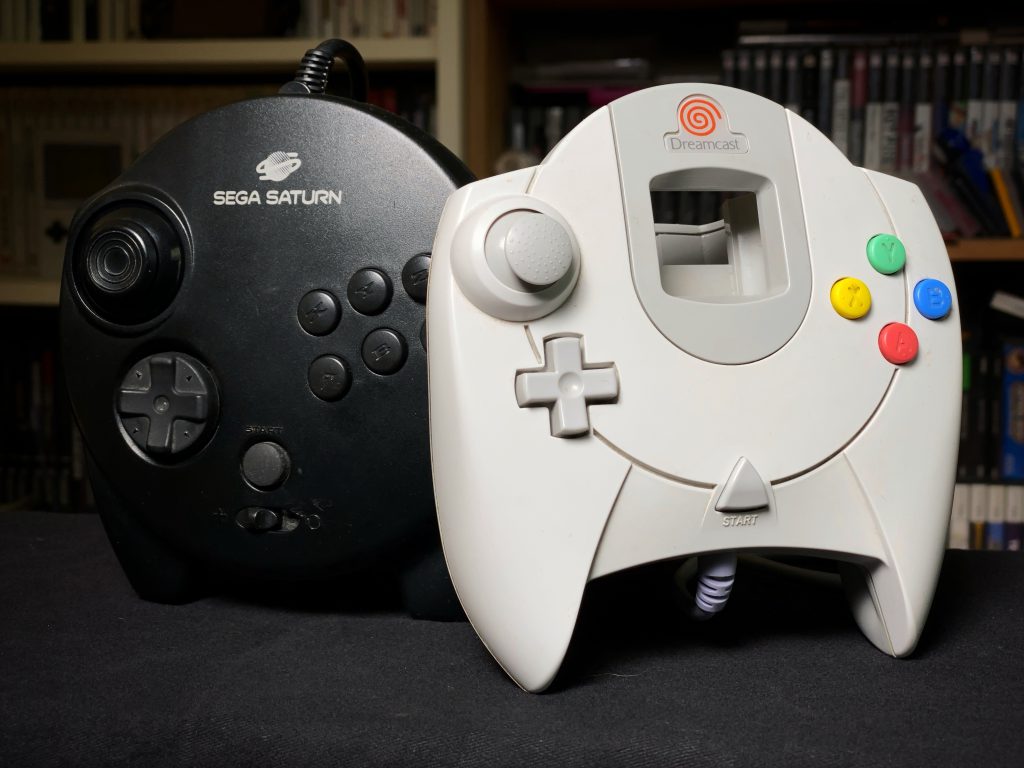
Released in Japan on November 27th, 1998, the Dreamcast’s controller iterated on the Saturn’s 3D Pad by slimming down, brightening up, and… removing two buttons? Okay, full disclosure: I am not a fan of the OEM Dreamcast controller. I think that VMUs are a cool idea—even when the low-battery alarm ruptures my ear drums—but there isn’t much else there for me. Whether it’s the painful angle of its grips, the bizarre decision to have its cable exit towards the player, or its convex analog stick made of hard plastic, it doesn’t take a lot of imagination to dream up a better Dreamcast pad.
If you’re sick of me waxing poetic and want to skip to the TL;DR, here’s the box blurb: Retro Fighters sets a new benchmark for Dreamcast controllers with the StrikerDC, but a few odd choices and cut corners hold it back from perfection. Read on to find out all the details!
The Connector:
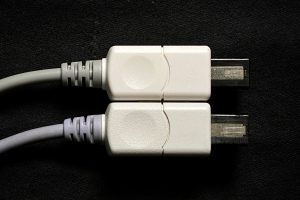
I have a lot of respect for companies that get connectors and plugs right, and Retro Fighters did a great job here. Connecting the Striker feels solid and satisfying, and if you put Retro Fighters’ connector next to an OEM plug they’re nearly indistinguishable. One thing I did notice is that there’s some texture missing from the proximal end of the plug, but you won’t really notice it in practice.
The Cable:
Moving towards the controller takes us down ten feet of cable, which is roughly fifty percent longer than the OEM design. In addition to the longer run, Retro Fighters includes what I believe to be a ferrite core near the connector to help reduce noise and interference. The cable itself isn’t quite as supple as the OEM one, and I miss the slight tinge of pale blue that the OEM’s sheath had, but neither has affected my experience much. The strain relief at both ends seems fairly robust, which hopefully means that it’ll stand up to years of abuse.
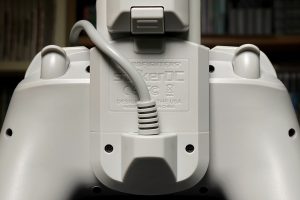
Of course, all of this is window dressing compared to my favourite improvement: THE CABLE EXITS AWAY FROM THE PLAYER! And it does so without interfering with any packs that extend past the back of the controller (e.g., the Jump Pack).
VMU Slots:
Just like the OEM design, you’ve got two slots for VMUs, Memory Cards, Jump Packs; even Microphone Packs! Broad support for first party accessories is a nice step up from Retro Fighters’ N64 Brawler pad, which was incompatible with the Game Boy Transfer Pak. Retro Fighters will only confirm support for first party accessories though, so if you have a bunch of third party memory or rumble packs then it might be a good idea to try before you buy.
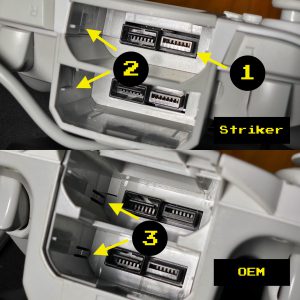
As for the slots themselves, Retro Fighters should again be commended for making connectors that look indistinguishable from the real deal. Once you start looking around the connectors though, differences begin to reveal themselves. The first thing I noticed was that inserting packs is a bit of a mixed bag. The slots have rails that guide packs to the connectors, just like in the OEM pad, but the Striker’s rail thickness is all over the place. My Striker’s forward slot had thicker rails, which made it much harder to slide the VMU in. The rails on the rear slot were thinner by comparison and did a good job of guiding my Jump Pack without needing extra force, but then the pack wasn’t held in place as firmly. Also—and I know this is going to be a super petty nit-pick—the Striker is missing the pressure tabs from the OEM design, which means you don’t get a satisfying click when your packs find their home. None of these issues are deal breakers, but at the very least I hope that Retro Fighters is able to refine the rail thickness in subsequent manufacturing runs.
Retro Fighters also took the time to make a few adjustments to the little window in the controller that lets you see your VMU’s screen. The window well is shallower now, which has the effect of letting in more light from oblique angles, and the crest at the top of the window has been removed. Other than allowing a firmer grip on a VMU when you’re unplugging it, it’s a pretty harmless aesthetic difference that you get used to quickly.
Face Buttons:
The Striker’s buttons land firmly in the uncanny valley; glance at them briefly and you’ll see the family resemblance, but the more time you spend with them the more differences you notice. It’s not always a bad thing, but die-hard Dreamcast fans might need some time to adjust.
Retro Fighters continues their tradition of including turbo functionality in their controllers. Hold down the button you want to enable Turbo for, hit the Turbo button, and it’ll have Turbo functionality until you hit the Cancel button. A simple but definitely appreciated feature. Also, Turbo/Cancel/Start/L Bumper/R Bumper are all switch mechanisms with strong, clicky feedback.
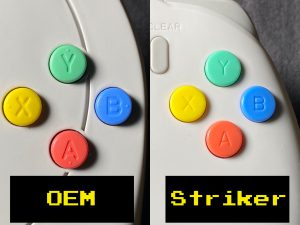
The ABXY buttons are fine on the whole. I’m ho-hum about their thinner font and chewable candy semi-translucent look, so I think it’s going to be more interesting to talk about the host of changes made to their feel and function.
The first change, which could be entirely due to my OEM’s wear and tear, is the way the button presses feel. There’s more travel than the OEM controller, but the feedback you get is firm and definitive. It doesn’t feel spongy or imprecise, and lends each press a more responsive feel. Again, it could be that my OEM controllers are so worn down that they’re not a great basis for comparison, but the three controllers I have feel similar enough that I’m prepared to say that the Striker has a snappier feel than the OEM design.
The next thing I noticed was that the small nub on each button has been removed. Maybe it’s just my soft city hands but I found those nubs uncomfortable and I’m happy to see them gone. There could be high level players with inch-thick calluses that need the extra texture for whatever reason, but I think everyone else is going to prefer the Striker’s buttons.
The last difference is subtle and almost imperceptible in isolation, but if you look closely you’ll see that the ABXY layout is slightly different on the Striker. The OEM controller has a rhomboid layout—where X/B are farther apart than Y/A—but the Striker has a narrower shape that is closer to a diamond. Will it make or break your combos in Soul Calibur? Probably not, but I’m also not a pro-level Dreamcast player. For speed runners or e-sports competitors, it could be the one thing standing between you and a personal best.
D-Pad:
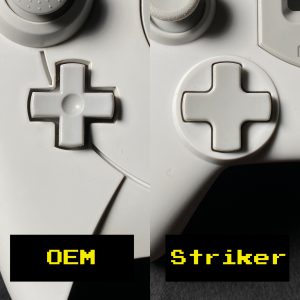
Just like ABXY, the Striker’s D-Pad feedback is snappy and firm. I’m also not especially offended by Sega’s OEM design though, which is taller, more concave, and pivots farther before a press is registered. If you like the OEM D-Pad then the Striker will take some time to get used to, especially if you’re doing plenty of sweeps in fighting games. I don’t play many Dreamcast games that benefit a ton from D-Pad control though, so I wouldn’t base your buying decision on my thoughts here.
The L/R Triggers
The L/R Triggers left me feeling conflicted. To start with the positives, the Striker’s triggers are generally more comfortable to use because they’re higher on the pad and have a more aggressive upward curve. I also prefer the textured finish on the Striker to the smooth hard plastic of the OEM pad, which can get slick if you’re in the middle of an extended gaming session. While the OEM pad shares more similarities with Microsoft’s pads, the Striker feels far more like the Dualshock 4.
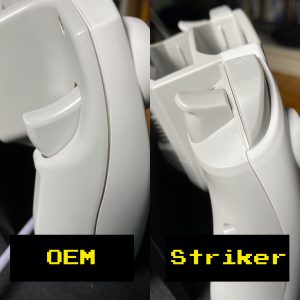
Unfortunately, I think the triggers are one of the Striker’s weak points. I have some minor gripes about the small amount of lateral play and their gritty feeling movement, but more than that I am put off by the resistance I feel as I near the end of their range. The OEM triggers provide a consistent level of tension throughout the pull, whereas the Striker’s triggers feel like you’re depressing a big, spongey membrane or something. Whatever is in the Striker gives you more resistance the farther you squeeze, until one point you just kind of reach the end without any definitive feedback. You’re never really that confident you’ve reached the end of the trigger’s range because of how squishy the landing is, and bouncing back for successive pulls isn’t as responsive as I’d like.
The Striker does give you another option though; Retro Fighters included shoulder bumpers with a switch mechanism that gives you solid, immediate feedback. The bumper sends the maximum analog value with every press, making repeated L/R inputs quicker to activate. As for their design, I find the Striker’s bumpers comparable to Microsoft’s or Nintendo’s controllers; totally serviceable, but less ideal than the triggers from an ergonomic perspective.
Sidebar: I had heard rumours that the Striker was incompatible with the DCDigital. Allegedly, there was some quirk with its triggers that made the key combo impossible to send, or something to that affect. I am glad to confirm that my Striker and my DCDigital work just fine together, and the OSD can be brought up by the triggers or the bumpers.
Analog Stick:
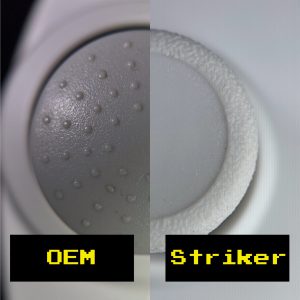
Rather than rehash the OEM’s design, the Striker’s analog stick has a concave centre and a soft, textured rim. To say that I’m fond of it would be an understatement, as the Dreamcast’s OEM stick is… not my favourite. Actually moving the Striker’s stick is a little strange though, because there’s almost no tension to it. I don’t think I’ve ever used an analog stick that feels so light, and it’ll definitely be off-putting to some users—something that Retro Fighters must have anticipated, because they reference it in the controller’s FAQ leaflet. I played Rez from start to finish without issue though, so it’s clearly still usable even if you’re accustomed to modern analog sticks.
As a possible corollary to the lower tension, the Striker has a smoother rotation than the OEM pad. The OEM’s analog stick has these pronounced grooves on cardinal and inter-cardinal positions, and you definitely feel like it takes a little bit of extra pressure to rock out of them. The Striker pad still has some of this feel, but it is toned down considerably and more enjoyable to use as a result.
Shell Design:
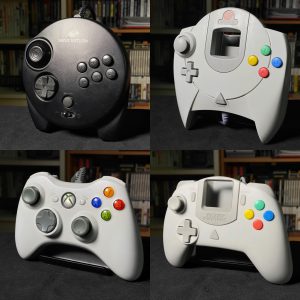
The Striker’s Dreamcast-by-way-of-Xbox360 shell is a breath of fresh air for gamers who chafed against the Dreamcast and Saturn 3D Pads. The grips jut out at a more comfortable angle, letting my wrists sit in a more natural position than the vertical grips of the OEM pad. As with most 3rd party hardware the materials don’t feel as thick and sturdy as an OEM design, but there’s also no creaking or flex if I try to torque them. The Striker is roughly 50g lighter than the OEM pad (155g vs 196g, respectively), but even without a VMU and a rumble pack inserted it’s not something you’re going to feel.
Final Thoughts:
Could the Striker be improved? Absolutely. Tossing aside low-hanging fruit like the mediocre triggers or the VMU slot rails, I feel like Retro Fighters acknowledged other fundamental shortcomings in the OEM pad without finding great solutions to them. They decreased the well depth of the VMU window so that more light could hit its screen, but if legibility in reduced lighting is a concern then why not find a way to install a user-toggled LED? Likewise, they know that triggers aren’t great for fighting games but instead of building in two more face buttons they used bumpers instead. It’s just a trend I’ve noticed with their designs, like how they changed the Z-Button on the OEM N64 pad to an analog-style trigger for their N64 Brawler. None of these omissions make the controller unusable, but I wish that Retro Fighters would go just a little farther to knock their designs out of the park.
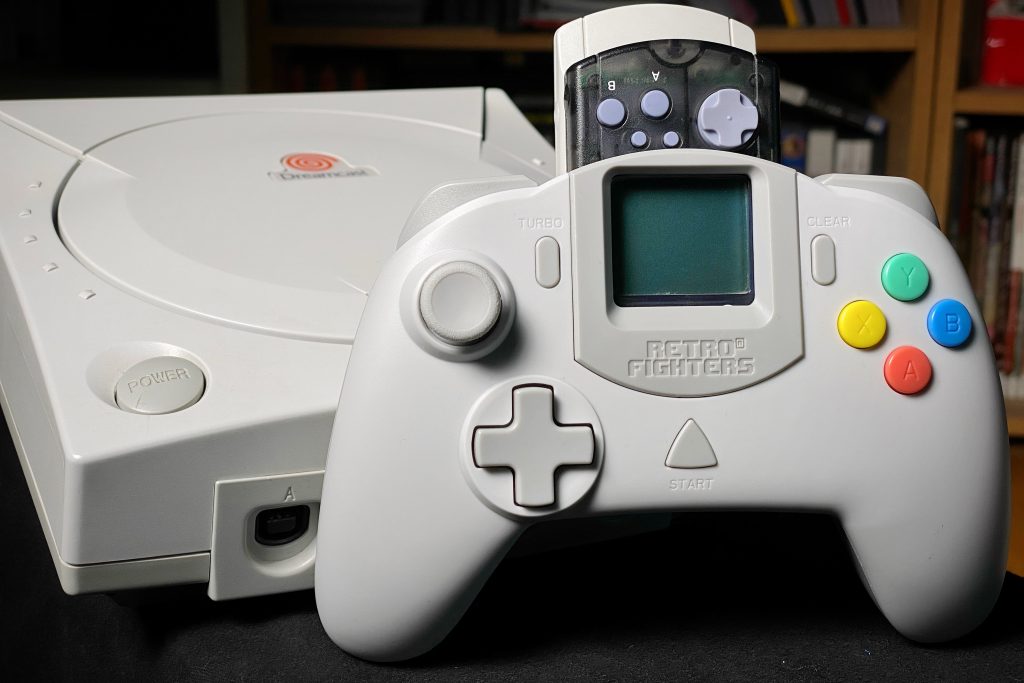 Still, what I want from a controller is a comfortable design and an intuitive layout that lets me focus on the game instead of the hardware in my hands. By those metrics, the Striker pad is a resounding success and does the admirable job of making the Dreamcast’s already excellent library even more fun to explore. There are diehard Dreamcast fans who will undoubtedly miss the OEM’s bizarre idiosyncrasies, but for the retro gaming enthusiast with modern sensibilities there is no greater third party Dreamcast pad than the StrikerDC.
Still, what I want from a controller is a comfortable design and an intuitive layout that lets me focus on the game instead of the hardware in my hands. By those metrics, the Striker pad is a resounding success and does the admirable job of making the Dreamcast’s already excellent library even more fun to explore. There are diehard Dreamcast fans who will undoubtedly miss the OEM’s bizarre idiosyncrasies, but for the retro gaming enthusiast with modern sensibilities there is no greater third party Dreamcast pad than the StrikerDC.
(Disclosure Statement) Retro Fighters did not supply a controller for this review. I backed the campaign personally and based my review on the unit I received.
